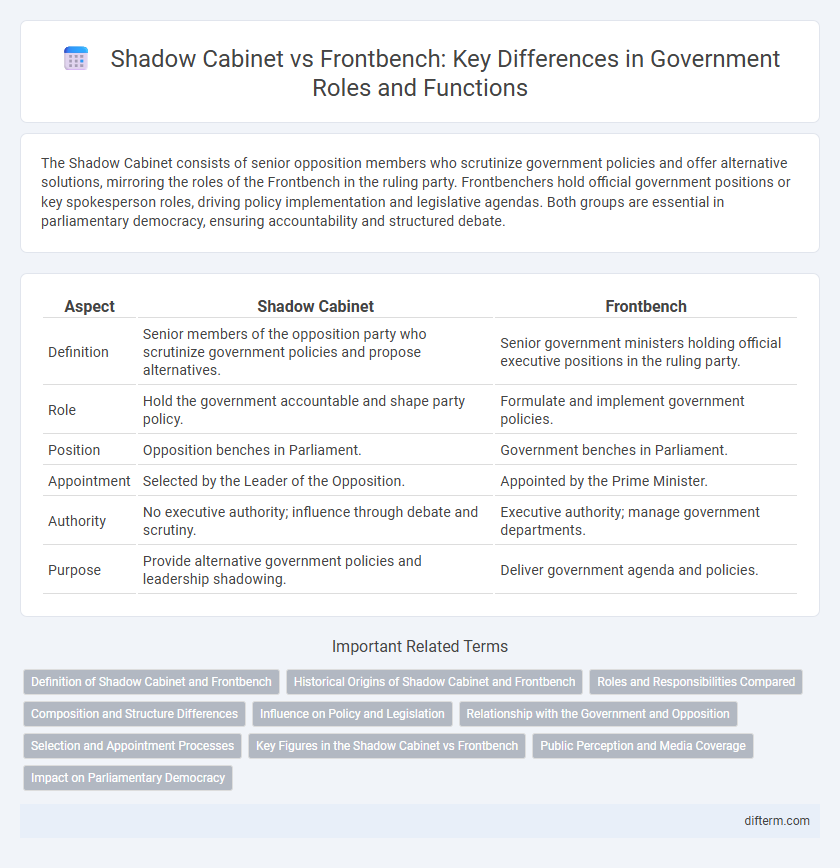The Shadow Cabinet consists of senior opposition members who scrutinize government policies and offer alternative solutions, mirroring the roles of the Frontbench in the ruling party. Frontbenchers hold official government positions or key spokesperson roles, driving policy implementation and legislative agendas. Both groups are essential in parliamentary democracy, ensuring accountability and structured debate.
Table of Comparison
| Aspect | Shadow Cabinet | Frontbench |
|---|---|---|
| Definition | Senior members of the opposition party who scrutinize government policies and propose alternatives. | Senior government ministers holding official executive positions in the ruling party. |
| Role | Hold the government accountable and shape party policy. | Formulate and implement government policies. |
| Position | Opposition benches in Parliament. | Government benches in Parliament. |
| Appointment | Selected by the Leader of the Opposition. | Appointed by the Prime Minister. |
| Authority | No executive authority; influence through debate and scrutiny. | Executive authority; manage government departments. |
| Purpose | Provide alternative government policies and leadership shadowing. | Deliver government agenda and policies. |
Definition of Shadow Cabinet and Frontbench
The Shadow Cabinet consists of senior opposition spokespeople who scrutinize and challenge the policies and actions of the government, each shadowing a specific government minister. The Frontbench refers to the leading members of both the government and opposition parties who sit on the front benches in the parliamentary chamber, including ministers and shadow ministers. This distinction highlights the Shadow Cabinet's role in holding the government accountable, while the Frontbench includes key policymakers and spokespersons from both sides.
Historical Origins of Shadow Cabinet and Frontbench
The concept of the Shadow Cabinet originated in the British parliamentary system during the late 19th century as an institutionalized opposition to the government's Frontbench ministers, enabling structured political accountability and policy scrutiny. Historically, Frontbench members have been government ministers responsible for specific departments, while Shadow Cabinet members mirror these roles to challenge and provide alternative policies. This dual structure has since become a cornerstone of Westminster-style democracies, emphasizing the balance between governance and opposition.
Roles and Responsibilities Compared
The Shadow Cabinet holds Leading members of the main opposition party tasked with scrutinizing and challenging specific government ministers' policies and actions, preparing alternative policies to government proposals. In contrast, Frontbenchers within the ruling party occupy executive roles, including ministers responsible for policymaking, administration, and implementation of government functions. While Shadow Cabinet members focus on accountability and policy critique, Frontbenchers actively manage government departments and steer legislative agendas.
Composition and Structure Differences
The Shadow Cabinet consists of senior members from the main opposition party who mirror the official government Frontbench team, each responsible for scrutinizing specific government departments. While the Frontbench includes ministers who hold executive authority and make policy decisions, the Shadow Cabinet functions without formal power, focusing primarily on accountability and developing alternative policies. Structurally, the Frontbench is part of the ruling government's leadership hierarchy, whereas the Shadow Cabinet operates as a unified opposition team organized to challenge and propose different approaches to government actions.
Influence on Policy and Legislation
The Shadow Cabinet plays a crucial role in scrutinizing government policies and proposing alternative legislation, directly influencing public debate and shaping party priorities. Frontbench members, particularly those in the ruling party, hold executive power to draft, implement, and amend legislation, driving government policy forward. Interaction between the Shadow Cabinet and Frontbench ensures robust democratic processes, with opposition oversight prompting government accountability and legislative refinement.
Relationship with the Government and Opposition
The Shadow Cabinet consists of senior members of the opposition party who scrutinize and challenge policies of the Government's Frontbench, which is composed of key ministers responsible for executive functions. This dynamic establishes a clear adversarial relationship where the Shadow Cabinet holds the Frontbench accountable, providing alternative policies and presenting itself as a government-in-waiting. The interaction between these entities is crucial for parliamentary democracy, ensuring transparency and continuous policy debate.
Selection and Appointment Processes
Shadow Cabinet members are selected by the leader of the opposition party, often choosing senior party members to mirror the government's frontbench roles. Frontbench appointments in the government are made by the Prime Minister, typically reflecting party loyalty, expertise, and parliamentary seniority. Both processes emphasize strategic placement to influence policy direction and parliamentary debates.
Key Figures in the Shadow Cabinet vs Frontbench
Key figures in the Shadow Cabinet are senior members of the opposition party assigned to scrutinize and challenge specific government departments, mirroring the roles of the Frontbench ministers who hold official positions in the government. The Shadow Cabinet includes roles such as Shadow Chancellor, Shadow Foreign Secretary, and Shadow Home Secretary, directly opposing the Chancellor of the Exchequer, Foreign Secretary, and Home Secretary from the Frontbench. These key figures in both the Shadow Cabinet and Frontbench play pivotal roles in policymaking, governance, and political accountability within the parliamentary system.
Public Perception and Media Coverage
The Shadow Cabinet often attracts intense media coverage due to its role as the official opposition, shaping public perception by scrutinizing government policies and proposing alternatives. Frontbench members in government typically receive favorable media treatment for their executive decisions and policy implementations, reinforcing their authority and credibility. Public perception tends to be influenced by the visibility and communication strategies of both groups, with the Shadow Cabinet seen as a government-in-waiting and the Frontbench viewed as current leaders.
Impact on Parliamentary Democracy
The Shadow Cabinet enhances parliamentary democracy by holding the government accountable through detailed policy scrutiny and presenting alternative governance options, fostering a competitive political landscape. Frontbenchers in government lead legislative agendas and implement policies, directly shaping national priorities and governance efficiency. The dynamic between the Shadow Cabinet and Frontbench ensures robust debate, increasing transparency and voter engagement in the democratic process.
Shadow Cabinet vs Frontbench Infographic

 difterm.com
difterm.com